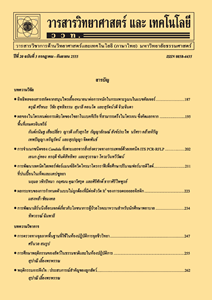คุณภาพด้านเคมีกายภาพและจุลชีววิทยาของผลิตภัณฑ์เครื่องดื่มผลไม้รวมชนิดผงเสริมแอสตาแซนธินที่สภาวะการเก็บรักษาต่าง ๆ
Main Article Content
Abstract
This research aimed to develop mixed fruit juice beverage powder added with natural astaxanthin from white shrimp (Litopenaeus vannamei) shell. Encapsulated astaxanthin powder was subjected to freeze drying together with cryogenic freezing whereas spray drying was employed to produce mixed fruit juice. The resultant product was determined for quality changes including color, moisture content, water activity, antioxidant properties and microbial loads at 30 ºC under various relative humidity conditions (0, 11, 33, and 52 %RH) for 2 months. Mixed fruit juice powder encapsulated with astaxanthin was fine and yellowish-orange in color represented as the coordinates L*, a*, b* and ∆E of 76.16, 19.39, 18.62 and 34.65, respectively. Its moisture content and water activity were 6.08 % and 0.32, respectively, with remarkable high antioxidant activity (96.88 % inhibition). The storage condition under 0 %RH was optimum, whereas the product could maintain its quality without significant changes in terms of color, moisture content and microbial loads. This study suggested that the encapsulated astaxanthin is a promising supplement for product development.
Article Details
References
[2] Naguib, Y.M.A, 2000, Antioxidant activities of astaxanthin and related carotenoids, J. Agric. Food Chem. 48: 1150-1154.
[3] Kittikalwan, P., Powthongsook, S., Pavasant, P. and Shotipruk, S., 2007, Encapsulation of Heamatococcus pluvialis using chitosan for astaxanthin stability enhancement, Carbohydr. Polym. 70: 378-385.
[4] Shen, Q. and Quek, S.Y., 2014, Microencap sulation of astaxanthin with blends of milk protein and fiber by spray drying, J. Food Eng. 123: 165-171.
[5] Taksima, T., Limpawattana, M. and Klaypradit, W., 2015, Astaxanthin encapsulated in beads using ultrasonic atomizer and application in yogurt as evaluated by consumer sensory profile, LWT Food Sci. Technol. 62: 431-437.
[6] Sangsuriyawong, A., Limpawattana, M., Siriwan, D., Kaewnern, P. and Klaypradit, W., 2016, Effects of phospholipid concentration and mixing methods on properties of astaxanthin extract-loaded liposomes, J. Agric. 32(3): 321-333. (in Thai)
[7] Ratanasiriwat, P., Worawattanamateekul, W. and Klaypradit, W., 2013, Properties of encapsulated wasabi flavor and its application in canned food, Int. J. Food Sci. Tech. 48: 749-757.
[8] Yoshii, H., Soottitantawat, S., Liu, X.D., Atarashi, T., Furuta, T., Aishima, S., Ohgawara, M. and Linko, P., 2001, Flavor release from spray-dried maltodextrin/ gum arabic or soy matrices as a function of storage relative humidity, Innov. Food Sci. Emerg. Technol. 2: 55-61.
[9] Stine, S.W., Song, I., Choi, C.Y. and Gerba, C.P., 2005, Effect of relative humidity on preharvest survival of bacterial and viral on the surface of cantaloupe lettuce and bell pepers, J. Food Prot. 68: 1352-1358.
[10] Association of Official Analytical Chemists, 2000, Official Method of Analysis of AOAC International, 17th Ed., Gaithersburg, Maryland.
[11] Shittu, T.A. and Lawal, M.O., 2007, Factors affecting instant properties of powdered cocoa beverages, Food Chem. 100: 91-98.
[12] Higuera-Ciapara, I., Felix-Valenzuela, L., Goycoolea, F.M. and Arguelles-Monal, W., 2004, Microencapsulation of astaxanthin in a chitosan matrix, Carbohyd. Polym. 56: 41-45.
[13] Bae, E.K. and Lee, S.W., 2008, Microencap sulation of avocado oil by spray drying using whey protein and maltodextrin, J. Microencapsul. 25: 549-560.
[14] Wu, H.C., Chen, H.M. and Shiau, C.Y., 2003, Free amino acids and peptides as related to antioxidant properties in protein hydrolysates of mackerel (Scomber austriasicus), Food Res. Int. 36: 949-957.
[15] American Public Health Association, 1992, Standard Methods for the Examination of Dairy Products, American Public Health Association, New York.
[16] Avila, E.L., Rodriguez, M.C. and Velasquez, H.J.C., 2015, Influence of maltodextrin and spray drying process conditions on sugarcane juice powder quality, Revista Faculted Nacional de Agronomia Medellin. 68: 7509-7520.
[17] Siew Young, Q., Ngan King, C. and Peter, S., 2007, The physicochemical properties of spray-dried watermelon powders, Chem. Eng. Process. 46: 386-392.
[18] Vongsawasdi, P., Nopharatana, M., Tang bumrungpong, D. and Apinunjarupong, S., 2002, Production of instant fruit and vegetable juice by spray dryer and microwave-vacuum dryer, KMUTT Res. Develop. J. 25(3): 257-277. (in Thai)
[19] Choi, E.J., Park, H.W., Chung, Y.B., Park, S.H., Park, S.H., Kim, J.S. and Chun, H.H., 2017, Effect of tempering methods on quality changes of pork loin frozen by cryogenic immersion, Meat Sci. 124: 69-76.
[20] Liu, H., Zeng, F., Wang, Q., Ou, S., Tan, L. and Gu, F., 2013, The effect of cryogenic grinding and hammer milling on the flavour quality of ground pepper (Piper nigrum L.), Food Chem. 141: 3402-3408.
[21] Sharma, L.K., Agarwal, D., Sharma, Y., Rathore, S.S. and Saxena, S.N., 2014, Cryogenic grinding technology enhances volatile oil, oleoresin and antioxidant activity of cumin (Cuminum cyminum L.), Int. J. Seed Spices. 4: 68-72.
[22] Saxena, S.N., Sharma, Y.K., Rathore, S.S., Singh, K.K., Barnwal, P., Saxena, R., Upadhyaya, P. and Anwer, M.M., 2013, Effect of cryogenic grinding on volatile oil, oleoresin contrnt and anti-oxidant propertics of coriander (Coriandrum sativum L.) genotypes, J. Food Sci. Technol. Mysore. 52: 568-573.
[23] Solval, K.M., Rodezno, L.A.E., Moncada, M., Bankston, J.D. and Sathivel, S., 2015, Evaluation of chotisan nanopartical as a glazing material for cryogenically frozen shrimp, LWT Food Sci. Technol. 57: 172-180.
[24] Food Code, Available Source: https://www.fda.gov/Food/GuidanceRegulation/RetailFoodProtection/FoodCode/ucm374275.htm, September 22, 2013.
[25] Pongjanyakul, T., 2012, Alginate: Natural Polymers into the Drug Delivery System, Klangnana Wittaya, Khon Kaen, 230 p. (in Thai)
[26] Soottitantawat, A., Takayama, K., Okamura, K., Muranaka, D., Yoshii, H., Furuta, T., Ohkawara, M. and Linko, P., 2005, Microencapsulation of l-menthol by spray during and its release characteristics, Innov. Food Sci. Emerg. Technol. 6: 163-170.
[27] Michalska. A., Wojdyto, A., Lech, K., Lysiak, G.P. and Figiel, A., 2016, Physicochemical properties of whole fruit plum powders obtained using different drying technologies, Food Chem. 207: 223-232.
[28] James, J. M., Loessner, M. J. and Golden, D.A., 2005, Modern food microbiology, Spinger Science Business Media, Inc., Berlin.


